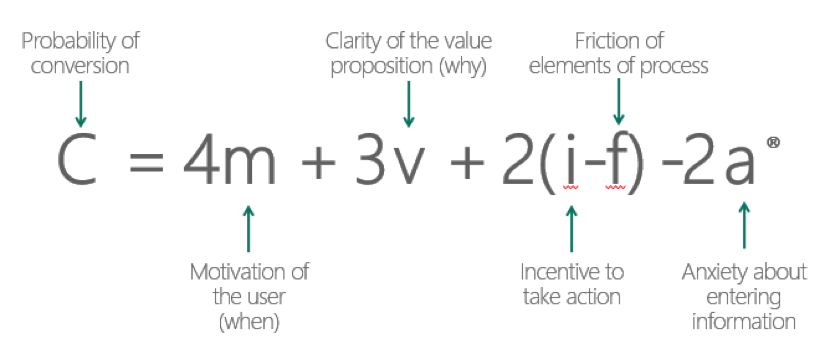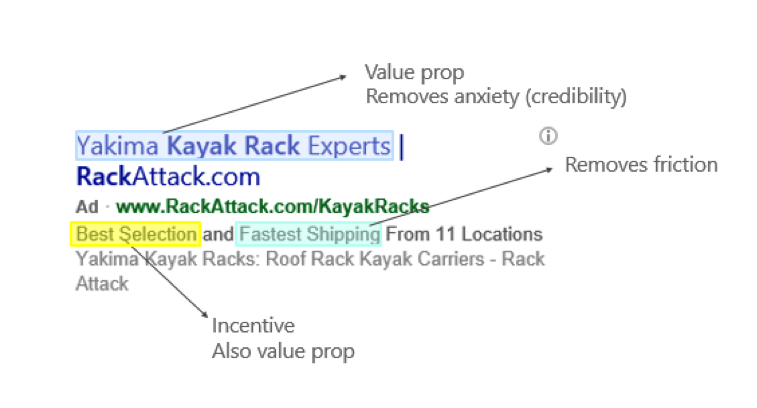I have a question for you: what’s the program you first turn to when creating your ad copy? If you’re like the majority of people today, your answer would be Excel.
Unfortunately, that might be the wrong answer.
While Excel is a fantastic program and is central to our day-to-day life in PPC, it’s not the best place to start with brainstorming ad copy.
Why?
If you’re writing text while constantly checking the length in the corresponding LEN() column, you’re stymieing your creativity. There’s a better way to create winning ads.
Let’s take charge of the whole process with a simple framework for brainstorming and ad copy creation that earns results.
The conversion formula
When in doubt, turn to science.
The conversion optimization industry is a fantastic source of inspiration here. It’s literally a part of their job to understand the target audience and pinpoint how to best persuade them to take action. Exactly what we want our ad copy to do.
The folks at MECLABS came up with a conversion formula that can be a framework for ad copy creation:

Let’s break this down. The formula says that the probability of conversion is dependent on:
- The motivation of the user (when am I ready to buy?)
- Plus the clarity of your value proposition (why should I buy from you?)
- Plus incentive to take action minus friction in the process
- Minus anxiety about giving personal information to complete the transaction.
Think of Zappos as an example of a business model that follows this formula. Their motivation and value proposition is a wide selection of shoes to fit a large variety of sizes at affordable prices, delivered right to your door. However, the shoe doesn’t always fit.
They understood the friction and anxiety points of the shoes not (Read more...) and having to spend money on return shipping. Cleverly, they minimized this by offering fast and free shipping- both ways. Think about it, would you shop from Zappos if they didn’t have free return shipping?
We can take this formula and apply to an ad copy framework.
It works best if we take each element from the formula as a focus point. We can then ideate on the best tactics to highlight the focus areas, and then go through and brainstorm potential messaging to speak to the tactic.
Here’s a sample of what it could look like:

This gives the brainstorming process a little more structure while still allowing for creative freedom. Ads can then be compiled and written by picking and choosing from the different focus points.
An ad that follows this conversion framework might look like this:

Using this framework for ad copy creation gives you three important things:
- More discipline in your copy brainstorming. The framework reminds you to hit from all angles, and you’re less likely to forget important points.
- You can share this with your client to explain your process and to make the case for trying something different.
- It can make you more organized as you build a library of copy that you’ve tried. Consider creating a grid where you enter new copy for each tactic.
A brainstorming suggestion that won’t make you roll your eyes
There’s a lot of research on the effectiveness (or non-effectiveness) of brainstorming. But the bottom line is that at some point you’re going to need to sit down and put some time into thinking about fresh ad copy. Whether you call that a brainstorm or a working session or lunchtime is up to you; it’s all of those.
I’ve found three steps to be pretty effective in coming up with new ad copy for paid search. I’ve also found that if I just do the same old thing over and over, I get no new ideas! So change things up and consider these tips:
1) Build your foundation
Another way to say this is “do your research.” Understand the voice of the customer, what their needs, fears and other triggers are. You can do this by surveying the customer certainly, but a faster and equally effective way to do this is by speaking to customer service reps. Ask them:
- How does your product or service help customers?
- Why do customers want to buy what you sell?
- What are most common questions you answer? Common objections you hear?
- And what about the competition; In what ways are they better than you? Or weaker?
- Is there a different audience for your product or service than you assume? For example, sailboat owners use climbing gear when they work on their masts; if you’re selling climbing gear, are you considering this audience?
In this part of the brainstorm, leave no stone unturned. Consider every possible angle, problem, solution and question.
2) Go crazy
This is where you actually start writing. And I strongly encourage you to step away from Excel; that application is not conducive to creative inspiration.
Instead, turn to Word or pull out a stack of plain paper, a lovely pen and cup of fresh coffee. Let your ideas come without thinking about word count. Just write it all down, free form.
To keep things organized, you might put ads into categories that fit the framework above. Some will hit especially hard on the value prop, some will be all about removing friction and some will combine all the aspects in the framework.
3) Create your final ads
Some people aren’t fond of editing down all their beautiful work; to me it’s the biggest joy because I know I’m mining for diamonds at this point. Find the ads that stand out to you and refine them.
Taking this top down approach means you can be more strategic about your ad extensions. You know your overarching messaging, so you can separate out the content that would be better as an ad extension, or tailor the overall ad based on which device it will show on.
When you’re done with all this creative work, you can get back to the comfort of Excel and your reports and data. But in the meantime, mine your creative streak for all it’s worth.
Do you have a special brainstorming practice for ad copy that you find is very effective? Please share it so we can all get smarter and more creative.
Purna Virji is Senior Bing Ads Client Development and Training Manager at Microsoft and a contributor to Search Engine Watch.
Related reading
Last week, Google announced that Accelerated Mobile Pages (AMP) are making their way into the organic mobile SERPs. While AMP is not a ranking ... read more
As I’ve been writing about tools and tactics quite a bit lately, I thought for this month’s column I’d take a step ... read more
You know, apart from the most obvious search engine. And possibly the second most obvious one too. In fact I’ll start again, ... read more
When trying to optimise a new blog for SEO, most individuals and businesses can get confused. There’s sometimes too much information, and guidance ... read more




